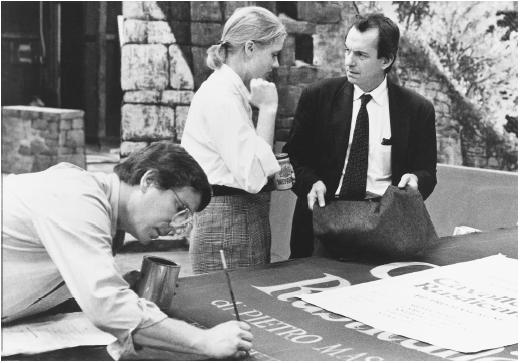Dean Tavoularis - Writer
Art Director. Nationality: American. Born: Lowell, Massachusetts, 1932. Education: Studied architecture at Otis Art Institute, Los Angeles. Career: Worked in animation department, then in live production, Walt Disney studios, before becoming art director. Awards: Academy Award, for The Godfather, Part II , 1974; British Academy Award, for Tucker: The Man and His Dream , 1988. Address: c/o Academy of Motion Picture Arts and Sciences, 8949 Wilshire Boulevard, Beverly Hills, CA 90211, U.S.A.
Film as Assistant Art Director:
- 1965
-
Ship of Fools (Kramer); Inside Daisy Clover (Mulligan)
Films as Art Director/Production Designer:
- 1967
-
Bonnie and Clyde (Penn)
- 1968
-
Candy (Marquand); Petulia (Lester)
- 1970
-
Zabriskie Point (Antonioni); Little Big Man (Penn)
- 1972
-
The Godfather (Coppola)
- 1974
-
The Conversation (Coppola); The Godfather, Part II (Coppola)
- 1975
-
Farewell, My Lovely (Richards)
- 1978
-
Apocalypse Now (Coppola); The Brink's Job (Friedkin)
- 1982
-
One from the Heart (Coppola); The Escape Artist (Deschanel); Hammett (Wenders)
- 1983
-
The Outsiders (Coppola); Rumble Fish (Coppola); Testament (Littman)
- 1986
-
Peggy Sue Got Married (Coppola)
- 1987
-
Gardens of Stone (Coppola); Heat (Richards); Un Homme amoreux ( A Man in Love ) (Kurys)
- 1988
-
Tucker: The Man and His Dream (Coppola)
- 1989
-
"Life without Zoe" ep. of New York Stories (Scorsese, Coppola and Allen)
- 1990
-
The Godfather, Part III (Coppola)
- 1992
-
Final Analysis (Joanou)
- 1993
-
Rising Sun (Kaufman)
- 1994
-
I Love Trouble (Shyer)

- 1996
-
Jack (Coppola)
- 1998
-
Bulworth (Beatty); The Parent Trap (N. Meyers)
- 1999
-
The Ninth Gate (Polanski)
- 2001
-
Angel Eyes
Publications
By TAVOULARIS: article—
Positif (Paris), September 1979.
Cine , vol. 2, no. 23, March 1980.
Cineaste (New York), vol. 23, no. 4, July 1998.
* * *
Since the mid-1960s, the production designs of Dean Tavoularis have been particularly noteworthy of his brilliant handling of twentieth-century period settings. Tavoularis trained as an architect at the Otis Art Institute and later worked as an animator for the Disney Studios before beginning his career as an art director and, ultimately, production designer.
His most notable work has appeared in films directed by Coppola and Antonioni. In addition, Tavoularis has developed a particular working relationship with the art director Angelo Graham. Tavoularis defines the production designer as the person who "should be involved in all visual aspects of the film," as opposed to the art director, who is primarily involved in the technical aspects of settings. Graham and Tavoularis worked together throughout the 1970s on films including The Godfather, Part II ; Farewell, My Lovely ; and Apocalypse Now .
Among his early work, Tavoularis was assistant set designer on Inside Daisy Clover , which makes conspicuous use of abstract set designs reflecting a nostalgia for the artifice of early 1930s Hollywood musicals. These sets recall the work of designers such as Van Nest Polglase and Anton Grot, but their style is more minimal, revealing an affinity with their own time. Likewise, as art director on Bonnie and Clyde , Tavoularis conceived an image of the Depression era so heavily glamorized as to sacrifice all but the barest traces of historical accuracy. This romantic image was conveyed through costumes, settings, and the highly artificial rosy and golden coloring used throughout the film. Nevertheless, his sets contain something of the spirit of the age they depict, and, although the film has not worn particularly well, the look of Bonnie and Clyde exerted a strong and lasting influence on fashion in both dress and décor.
Set in the contemporary American west, Antonioni's Zabriskie Point contrasted harsh reality with nostalgic escapism—the heroine drives a 20-year-old Buick—both of which were finely represented by the exactness of details of setting, properties, and costume, all under the supervision of Tavoularis. His background in animation may have lent authenticity to the "explosion" sequence towards the end of the film in which the contents of a well-appointed modern American residence are blasted into the atmosphere in slow motion. This minute examination of domestic consumerism encapsulates the attitudes of the film towards bourgeois materialism in a time of political unrest.
Tavoularis's work moved from the somewhat naive historicism of Bonnie and Clyde to the more archaeologically accurate portrayal of twentieth-century styles in Coppola's The Godfather (both parts) in which the panoramic history of the Corleone family is set against insightful and precise backgrounds relating not only to the particular historical moment but also to the changing moods and the ethnic qualities of the narrative. Farewell, My Lovely continued the archaeological approach even more ambitiously as Tavoularis designed the revival, in color, of a classic 1940s film noir. His masterful handling of a subdued color range and his sophisticated use of the telling detail support Tavoularis's position at the top of his profession.
—Gregory Votolato
Comment about this article, ask questions, or add new information about this topic: